Overexpressing temperature-sensitive dynamin decelerates phototransduction and bundles microtubules in Drosophila photoreceptors
- PMID: 19906968
- PMCID: PMC2833399
- DOI: 10.1523/JNEUROSCI.2873-09.2009
Overexpressing temperature-sensitive dynamin decelerates phototransduction and bundles microtubules in Drosophila photoreceptors
Abstract
shibire(ts1), a temperature-sensitive mutation of the Drosophila gene encoding a Dynamin orthologue, blocks vesicle endocytosis and thus synaptic transmission, at elevated, or restrictive temperatures. By targeted Gal4 expression, UAS-shibire(ts1) has been used to dissect neuronal circuits. We investigated the effects of UAS-shibire(ts1) overexpression in Drosophila photoreceptors at permissive (19 degrees C) and restrictive (31 degrees C) temperatures. At 19 degrees C, overexpression of UAS-shi(ts1) causes decelerated phototransduction and reduced neurotransmitter release. This phenotype is exacerbated with dark adaptation, age and in white mutants. Photoreceptors overexpressing UAS-shibire(ts1) contain terminals with widespread vacuolated mitochondria, reduced numbers of vesicles and bundled microtubules. Immuno-electron microscopy reveals that the latter are dynamin coated. Further, the microtubule phenotype is not restricted to photoreceptors, as UAS-shibire(ts1) overexpression in lamina cells also bundles microtubules. We conclude that dynamin has multiple functions that are interrupted by UAS-shibire(ts1) overexpression in Drosophila photoreceptors, destabilizing their neural communication irreversibly at previously reported permissive temperatures.
Figures
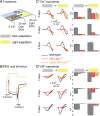




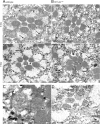
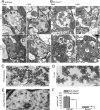
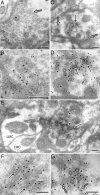
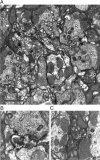
Similar articles
-
Unique biochemical and behavioral alterations in Drosophila shibire(ts1) mutants imply a conformational state affecting dynamin subcellular distribution and synaptic vesicle cycling.J Neurobiol. 2002 Nov 15;53(3):319-29. doi: 10.1002/neu.10101. J Neurobiol. 2002. PMID: 12382260
-
Conditional modification of behavior in Drosophila by targeted expression of a temperature-sensitive shibire allele in defined neurons.J Neurobiol. 2001 May;47(2):81-92. doi: 10.1002/neu.1018. J Neurobiol. 2001. PMID: 11291099
-
Conditional disruption of synaptic transmission induces male-male courtship behavior in Drosophila.Proc Natl Acad Sci U S A. 2002 Oct 1;99(20):13232-7. doi: 10.1073/pnas.202489099. Epub 2002 Sep 18. Proc Natl Acad Sci U S A. 2002. PMID: 12239352 Free PMC article.
-
The dynamins: redundant or distinct functions for an expanding family of related GTPases?Proc Natl Acad Sci U S A. 1997 Jan 21;94(2):377-84. doi: 10.1073/pnas.94.2.377. Proc Natl Acad Sci U S A. 1997. PMID: 9012790 Free PMC article. Review.
-
The function of dynamin in endocytosis.Curr Opin Neurobiol. 1995 Oct;5(5):559-65. doi: 10.1016/0959-4388(95)80059-x. Curr Opin Neurobiol. 1995. PMID: 8580706 Review.
Cited by
-
Transient and specific inactivation of Drosophila neurons in vivo using a native ligand-gated ion channel.Curr Biol. 2013 Jul 8;23(13):1202-8. doi: 10.1016/j.cub.2013.05.016. Epub 2013 Jun 13. Curr Biol. 2013. PMID: 23770187 Free PMC article.
-
Mild functional differences of dynamin 2 mutations associated to centronuclear myopathy and Charcot-Marie Tooth peripheral neuropathy.PLoS One. 2011;6(11):e27498. doi: 10.1371/journal.pone.0027498. Epub 2011 Nov 11. PLoS One. 2011. PMID: 22096584 Free PMC article.
-
Disruption of Endocytosis with the Dynamin Mutant shibirets1 Suppresses Seizures in Drosophila.Genetics. 2015 Nov;201(3):1087-102. doi: 10.1534/genetics.115.177600. Epub 2015 Sep 4. Genetics. 2015. PMID: 26341658 Free PMC article.
-
The functional organisation of glia in the adult brain of Drosophila and other insects.Prog Neurobiol. 2010 Apr;90(4):471-97. doi: 10.1016/j.pneurobio.2010.01.001. Epub 2010 Jan 29. Prog Neurobiol. 2010. PMID: 20109517 Free PMC article. Review.
-
Thermoresponsive motor behavior is mediated by ring neuron circuits in the central complex of Drosophila.Sci Rep. 2021 Jan 8;11(1):155. doi: 10.1038/s41598-020-80103-9. Sci Rep. 2021. PMID: 33420240 Free PMC article.
References
-
- Acharya U, Patel S, Koundakjian E, Nagashima K, Han X, Acharya JK. Modulating sphingolipid biosynthetic pathway rescues photoreceptor degeneration. Science. 2003;299:1740–1743. - PubMed
-
- Bähner M, Frechter S, Da Silva N, Minke B, Paulsen R, Huber A. Light-regulated subcellular translocation of Drosophila TRPL channels induces long-term adaptation and modifies the light-induced current. Neuron. 2002;34:83–93. - PubMed
-
- Beramendi A, Peron S, Casanova G, Reggiani C, Cantera R. Neuromuscular junction in abdominal muscles of Drosophila melanogaster during adulthood and aging. J Comp Neurol. 2007;501:498–508. - PubMed
-
- Borycz J, Borycz JA, Kubów A, Lloyd V, Meinertzhagen IA. Drosophila ABC transporter mutants white, brown and scarlet have altered contents and distribution of biogenic amines in the brain. J Exp Biol. 2008;211:3454–3466. - PubMed
-
- Brand AH, Perrimon N. Targeted gene expression as a means of altering cell fates and generating dominant phenotypes. Development. 1993;118:401–415. - PubMed
Publication types
MeSH terms
Substances
Grants and funding
- BBF0120711/BB_/Biotechnology and Biological Sciences Research Council/United Kingdom
- BBD0019001/BB_/Biotechnology and Biological Sciences Research Council/United Kingdom
- R01 EY003592/EY/NEI NIH HHS/United States
- R03 AT002839/AT/NCCIH NIH HHS/United States
- BB/F012071/1/BB_/Biotechnology and Biological Sciences Research Council/United Kingdom
LinkOut - more resources
Full Text Sources
Molecular Biology Databases
